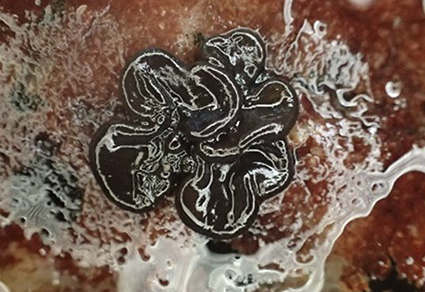Abstract
Trickling water on nearly vertical rocky substrates is a common feature of mountainous regions of Japan. The thin water film is inhabited by discoid colonies of the cyanobacteria Nostoc. This species resembles the North American Nostoc parmelioides Kützing, which forms ear-like colonies in stream beds and is inhabited by symbiotic chironomid larvae. The Nostoc colony in Japan was inhabited by a chironomid larva inside a ring-shaped burrow in the colony. Morphological analyses suggested that these individuals belong to a new species closely related to Cricotopus spp. symbiotic with Nostoc parmelioides. Here, we described the chironomid species Cricotopus cataractaenostocicola sp. nov. The species was distinguished from other congeneric species mainly by the morphology of male hypopygia. It has an anal point and long setae on the outside of the gonocoxite, and does not have setae near the apex of the inner lobe in the gonocoxite. Almost all the Nostoc colonies contained one large larva or pupa. The outer layer of the chironomid-symbiotic Nostoc colony had an elastic hardness. The 3D computer tomography (3DCT) scan showed a connected network of internal passages that are sufficiently wide to be traversed by the larvae, suggesting that cavities are present for the larvae to pass through. Future studies should investigate the formation of cavities and their purpose. As pioneers in the observation of living organisms using 3DCT, we provided the CT data to the Natural History Museum in Vienna.
References
Armitage, P.D., Cranston, P.S. & Pinder, L.C. (1995) The Chironimidae Biology and Ecology of Nonbiting Midges. Springer, Berlin, 572 pp.
Ashe, P. & Murray, D.A. (1980) Nostococladius, a new subgenus of Cricotopus (Diptera: Chironomidae). In: Chironomidae Ecology, Systematics, Cytology & Physiology. Pergamon Press, Oxford, pp. 105–111. https://doi.org/10.1016/B978-0-08-025889-8.50021-0
Brock, E.M. (1960) Mutualism between the midge Cricotopus and the alga Nostoc. Ecology, 41 (3), 474–483. https://doi.org/10.2307/1933322
Cuppen, H., Gresens, S.E. & Tempelman, D. (2020) Description of the larvae of Cricotopus festivellus (Kieffer 1906) and Cricotopus diversus (Boesel 1983) with keys to discrimination of larval, pupal and adult stages (Diptera: Chironomidae). Chironomus Journal of Chironomidae Research, 33, 4–16. https://doi.org/10.5324/cjcr.v0i33.2985
Dodds, W.K. & Marra, J.L. (1989) Behaviors of the midge, Cricotopus (Diptera: Chironomidae) related to mutualism with Nostoc parmelioides (Cyanobacteria). Aquatic Insects, 11 (4), 201–208. https://doi.org/10.1080/01650428909361372
Edler, D., Klein, J., Antonelli, A. & Silvestro, D. (2021) raxmlGUI 2.0: A graphical interface and toolkit for phylogenetic analyses using RAxML. Methods in Ecology and Evolution, 12, 373–377. https://doi.org/10.1111/2041-210X.13512
Edwards, F.W. (1929) British non-biting midges (Diptera, Chironomidae). Transactions of the Royal Entomological Society of London, 77, 279–430. https://doi.org/10.1111/j.1365-2311.1929.tb00692.x
Folmer, O., Black, M., Hoeh, W., Lutz, R. & Vrijenhoek, R. (1994) DNA primers for amplification of mitochondrial cytochrome c oxidase subunit I from diverse metazoan invertebrates. Molecular Marine Biology and Biotechnology, 3 (5), 294–299.
Gouy, M., Guindon, S. & Gascuel, O. (2010) SeaView version 4: A multiplatform graphical user interface for sequence alignment and phylogenetic tree building. Molecular Biology and Evolution, 27, 221–224. https://doi.org/10.1093/molbev/msp259
Hirvenoja, M. (1973) Revision der Gattung Cricotopus van der Wulp und ihrer Verwandten (Diptera, Chironomidae). Annales Zoologici Fennici, 10, 1–363.
Imada, Y. (2020) A novel leaf-rolling chironomid, Eukiefferiella endobryonia sp. nov. (Diptera, Chironomidae, Orthocladiinae), highlights the diversity of underwater chironomid tube structures. ZooKeys, 906, 73–111. https://doi.org/10.3897/zookeys.906.47834
Kawai, K., Saito, H. & Anno, T. (2016) Genetic relationships of 33 genera of the subfamily Orthocladiinae in Japan. Japanese Journal of Limnology, 78, 45–50. https://doi.org/10.3739/rikusui.78.45
Li, X., Lin, X., Wang, X. (2014) Nostocoladius, a newly recorded subgenus of Cricotopus van der Wulp () Diptera: Chironimidae) from Oriental Region. Entomotaxonomia, 36 (3), 201-205.
Prat, N., Paggi, A., Ribera, C., Acosta, R., Ríos-Touma, B., Villamarín, C., Rivera, F., Ossa, P. & Rieradevall, M. (2018) The Cricotopus (Oliveiriella) (Diptera: Chironomidae) of the high altitude Andean streams, with description of a new species, C. (O.) rieradevallae. Neotropical Entomology, 47, 256–270. https://doi.org/10.1007/s13744-017-0548-5
Sabater, S. & Muñoz, I. (2000) Nostoc verrucosum (Cyanobacteria) colonized by a chironomid larva in a Mediterranean stream (Note). Journal of Phycology, 36 (1), 59–61. https://doi.org/10.1046/j.1529-8817.2000.99100.x
Sasa, M. (1979) A morphological study of adults and immature stages of 20 Japanese species of the family Chironomidae (Diptera). Research Reports from the National Institute for Environmental Studies, Japan, 7, 1–148.
Sasa, M. (1981) Studies on chironomid midges of the Tama River Part 4. Chironomidae recorded at a winter survey. Research Reports from the National Institute for Environmental Studies, Japan, 29, 79–148.
Sasa, M. & Kikuchi, M. (1995) Chironomidae (Diptera) of Japan. University of Tokyo Press, Tokyo, 333 pp.
Sasa, M. (1989) Chironomidae of Japan: Checklist of species recorded, key to males and taxonomic notes. Research Report from the National Institute for Environmental Studies, Japan, 125, 1–177.
Sasa, M. (1998) Studies on the chironomids collected throughout the year in the Shofuku Garden, near the mouth of Kurobe River, Toyama. Part 1. Bulletin of Toyama Prefectural Environmental Pollution Research Center, 25 (3), 14–69.
Sasa, M., Suzuki, H. & Sakai, T. (1998) Studies on the chironomid midges collected on the shore of Shimanto River in April, 1998, Part 2. Description of additional species belonging to Orthocladiinae, Diamesinae and Tanypdinae. Tropical Medicine, 40 (3), 99–147.
Silvestro, D. & Michalak, I. (2012) raxmlGUI: A graphical front-end for RAxML. Organisms Diversity and Evolution, 12, 335–337. https://doi.org/10.1007/s13127-011-0056-0
Tanabe, A.S. (2011) Kakusan4 and Aminosan: Two programs for comparing nonpartitioned, proportional and separate models for combined molecular phylogenetic analyses of multilocus sequence data. Molecular Ecology Resources, 11 (5), 914–921. https://doi.org/10.1111/j.1755-0998.2011.03021.x
Ward, A.K., Dahm, C.N. & Cummins, K.W. (1985) Nostoc (cyanophyta) productivity in Oregon stream ecosystems: Invertebrate influences and differences between morphological types. Journal of Phycology, 21, 223–227. https://doi.org/10.1111/j.0022-3646.1985.00223.x
Wirth, W.W. (1957) The species of Cricotopus midges living in the blue-green alga Nostoc in California. Pan-Pacific Entomologist, 33, 121–126.
Yamauchi, Y., Tenjimbayashi, M., Samitsu, S. & Naito, M. (2019) Durable and flexible superhydrophobic materials: abrasion/scratching/slicing/droplet impacting/bending/twisting-tolerant composite with porcupinefish-like structure. ACS Applied Materials and Interfaces, 11, 32381–32389. https://doi.org/10.1021/acsami.9b09524


